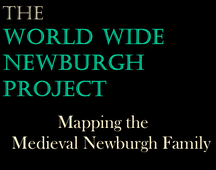|
|
THE CHURCH OF ST. ANDREW was dedicated on Crown lands 27 May 1225.
However, an earlier charter and records of 1165 shows the church was in existence as early as 1150. William de Merton, Augustinian Canon of Sarum witnessed the ordination. From its inception, the Priory of Merton collected pensions from certain affiliated churches. Written records state, in 1312 the Prior of Merton was the main patron of St. Andrew until 1361 when Edward III became patron. (Vetus Registrum Ecclesie Sarum, Vol. II, 219, 237, 256, 279; Victoria History of the County of Dorset, Vol. II, London, 1908, 11)
King Henry II, confirmed to the “Church of Merton and the Canons serving God, all donations of land and men and alms.” The charter was witnessed by Routrou Newburgh, Archbishop of Evereux and Rouen. (Heales, London, 1898, 23) The Archbishop’s involvement demonstrated the Newburgh family’s ongoing ecclesiastical participation with the Catholic Church in England, France and Wales. Their military skills and fealty were rewarded with large land grants held both in capite and in fee.
Rotrou’s sibling Robert inherited substantial holdings in Dorset from their father Henry Newburgh, 1st Earl of Warwick. Robert remained in Normandy as Lord of Newburgh Castle and served as Seneschal and Justice of Normandy. His son Roger stepped into the Dorset lordship when he married Maude, granddaughter of Henry I’s chamberlain, William Glastonia. Roger and Maude worked with the Cistercian order to develop the second Bindon Abbey at Wool in 1172. Their family and retainers granted many satellite properties in Dorset and other counties to Cistercian use.
While the identity of the party who commissioned the ORIGINAL ST. ANDREW CHURCH is unknown, regnal dating infers it was built in Henry III’s reign. The Bindon Abbey charter of 1233 specified Robert Newburgh held the MANOR OF LULWORTH as tenant-in-chief. Given the Newburgh’s luminary status with the king, they likely held the manor much earlier than recorded by this charter. St. Andrew’s church was located under a half mile uphill from the first abbey at Little Bindon. If descriptions by 18th century historian John Hutchins are accurate, this ancient church was something more than a typical parish church.
Four centuries later circa 1630 St. Andrew's was again affirmed as the parish church of East-West Lulworth. However, it had migrated to Lulworth Park, some 1.25 miles east of the original manor of Lulworth/St. Andrew. Today the elegant tower is all that remains of the original 13th century fabric. The dates of St. Andrew's transfer and reconstruction are approximate, but seem to have occurred around 1630 before the Welds purchased the property in 1641 from the 2nd Earl of Suffolk.
After the harsh move, St. Andrew barely survived. In the 18th century it narrowly escaped total destruction and subsequently underwent two major renovations (1788 and 1864). A third occurred in 1897 to save the tower. Reduced in grandeur, and stripped of its former history, it has endured into this century.
Historian John Hutchins first described St. Andrew as bearing classic Norman architecture in his History and Antiquities of Dorset (1774). However, due to its thirteenth century dedication and subsequent relocation, his architectural characterization is a bit awkward. Built in 1225 or before, it should be recognized as Early English Gothic.
Hutchins’ watershed work was posthumously published before the first renovation of St. Andrew commenced in 1788. Though he seemed unaware of the church’s relocation or dedicatory dates, he may have suspected its relocation due to architectural idiosyncrasies mentioned in his notes.
However, Thomas Hardy the renown novelist and conservationist was quite aware of the history of St. Andrew and worked with John Hicks during it's last restoration. During the 19th century, he stood in support of St. Andrew’s church at Lulworth, and others, recounting its 13th century antiquity after 19th century renovations. His discussions with the Society for Protection of Ancient Buildings (SPAB) are particularly enlightening. In magazine articles written during the period, he said, ". . . and it is evident that here was once a building of considerable architectural pretensions, though eighteenth century architects in their efforts of "improvement” considerably marred the beauty of the original design; [St. Andrew's] tower fortunately remained untouched, as if to put to shame the meanness of more modern innovations on the former beautiful style.” ~Thomas Hardy, 1864
The renovations appear to have changed St. Andrew’s architectural style from Early English Gothic to Perpendicular. Perplexingly, historians now date the tower as fifteenth century. However, twentieth century archaeological reports claim where St. Andrew's now stands, no habitation occurred until the seventeenth century. Considering Hutchins’ early work, this calls into question the veracity of overly enthusiastic Victorian and contemporary historians' conclusions.
Ecclesiastical registers from the 12th century have been combined with modern St. Andrew records. Crossover dating during the 16th century represent strong evidence of relocation. A full review of evidences will appear in my upcoming publication, The Lost Legacy of St. Andrew's Church and Medieval Lulworth; The development of East/West Lulworth.
Additional information about East Lulworth and St. Andrew's church can be found here.

